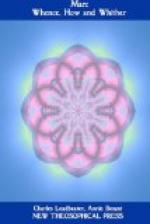We have already seen that any animal devotes to reproduction the balance between income and expenditure of nutriment. Now, the digestive system is here well developed, and the income is large. But we have already noticed that, as animals grow larger, the ratio between the digestive surface and the mass to be supported grows continually smaller. On account of size alone the mammal has but a small balance. But the amount of expenditure is proportional to the mass and activity of the muscular and nervous systems. And the mammal is, and from the beginning had to be, an exceedingly active, energetic, and nervous animal. The income has increased, but the expenses have far outrun the increase. The mammal can devote but little to reproduction.
Moreover, it requires a large amount of material to form a mammalian egg, such as that of the monotreme. It requires indefinitely more nutriment to build a mammal than a worm, for the former is not only larger and more perfect at birth; it is also vastly more complicated. The embryonic journey has, so to speak, lengthened out immensely. One monotreme egg represents more economy and saving than a thousand eggs of a worm. Moreover, where the individuals are longer lived and the generations follow one another at longer intervals, the number of favorable variations and the possibility of conformity to environment through these is greatly lessened. In such a group it is of the utmost importance that every egg should develop; the destruction of a single one is a real and important loss to the species. It is not enough to produce such an egg; it must be most scrupulously guarded. Even the egg of the platypus is deposited in a nest in a hole in the bank, and the female Echidna carries the egg in a marsupial pouch until it develops.




